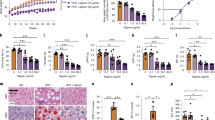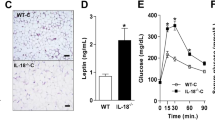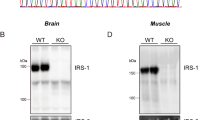Abstract
Here we report the presence of hyperphagia, obesity and insulin resistance in knockout mice deficient in IL-18 or IL-18 receptor, and in mice transgenic for expression of IL-18 binding protein. Obesity of Il18−/− mice resulted from accumulation of fat tissue based on increased food intake. Il18−/− mice also had hyperinsulinemia, consistent with insulin resistance and hyperglycemia. Insulin resistance was secondary to obesity induced by increased food intake and occurred at the liver level as well as at the muscle and fat-tissue level. The molecular mechanisms responsible for the hepatic insulin resistance in the Il18−/− mice involved an enhanced expression of genes associated with gluconeogenesis in the liver of Il18−/− mice, resulting from defective phosphorylation of STAT3. Recombinant IL-18 (rIL-18) administered intracerebrally inhibited food intake. In addition, rIL-18 reversed hyperglycemia in Il18−/− mice through activation of STAT3 phosphorylation. These findings indicate a new role of IL-18 in the homeostasis of energy intake and insulin sensitivity.
This is a preview of subscription content, access via your institution
Access options
Subscribe to this journal
Receive 12 print issues and online access
$209.00 per year
only $17.42 per issue
Buy this article
- Purchase on SpringerLink
- Instant access to full article PDF
Prices may be subject to local taxes which are calculated during checkout




Similar content being viewed by others
References
Joosten, L.A. et al. An IFN-gamma-independent proinflammatory role of IL-18 in murine streptococcal cell wall arthritis. J. Immunol. 165, 6553–6558 (2000).
Netea, M.G. et al. Neutralization of interleukin-18 reduces neutrophil tissue accumulation and protects mice against lethal Escherichia coli and Salmonella typhimurium endotoxemia. J. Immunol. 164, 2644–2649 (2000).
Dinarello, C.A. IL-18: A Th1-inducing, proinflammatory cytokine and a new member of the IL-1 family. J. Allergy Clin. Immunol. 103, 11–24 (1999).
Ghayur, T. et al. Caspase-1 processes IFN-γ-inducing factor and regulates LPS-induced IFN-γ production. Nature 386, 619–623 (1997).
Novick, D. et al. Interleukin-18 binding protein: a novel modulator of the Th1 cytokine response. Immunity 10, 127–136 (1999).
Moriwaki, Y. et al. Elevated levels of interleukin-18 and tumor necrosis factor-alpha in serum of patients with type 2 diabetes mellitus: relationship with diabetic nephropathy. Metabolism 52, 605–608 (2003).
Escobar-Morreale, H.F., Botella-Carretero, J.I., Villuendas, G., Sancho, J. & San Millan, J.L. Serum interleukin-18 concentrations are increased in the plycystic ovary syndrome: relationship to insulin resistance and obesity. J. Clin. Endocrinol. Metab. 89, 806–811 (2004).
Esposito, K. et al. Inflammatory cytokine concentrations are acutely increased by hyperglycemia in humans. Circulation 106, 2067–2072 (2002).
Reaven, G.M. Role of insulin resistance in human disease (syndrome X): an expanded definition. Annu. Rev. Med. 44, 121–131 (1993).
Inoue, H. et al. Role of STAT-3 in regulation of hepatic gluconeogenic genes and carbohydrate metabolism in vivo. Nat. Med. 10, 168–174 (2004).
Blaskovich, M.A. et al. Discovery of JSI-124 (cucurbitacin I), a selective Janus kinase/signal transducer and activator of transcription 3 signaling pathway inhibitor with potent antitumor activity against human and murine cancer cells in mice. Cancer Res. 63, 1270–1279 (2003).
Ishibashi, S., Goldstein, J.L., Brown, M.S., Herz, J. & Burns, D.K. Massive xanthomatosis and atherosclerosis in cholesterol-fed low density lipoprotein receptor-negative mice. J. Clin. Invest. 93, 1885–1893 (1994).
Gao, Q. et al. Disruption of neural signal transducer and activator of transcription 3 causes obesity, diabetes, infertility, and thermal dysregulation. Proc. Natl. Acad. Sci. USA 101, 4661–4666 (2004).
Bjorbaek, C., El-Haschimi, K., Frantz, D.F. & Flier, J.S. The role of SOCS-3 in leptin signaling and leptin resistance. J. Biol. Chem. 274, 30059–30065 (1999).
Ueki, K., Kondo, T., Tseng, Y.H. & Kahn, C.R. Central role of suppressors of cytokine signaling proteins in hepatic steatosis, insulin resistance, and the metabolic syndrome in the mouse. Proc. Natl. Acad. Sci. USA 101, 10422–10427 (2004).
Pocai, A. et al. Central leptin acutely reverses diet-induced hepatic insulin resistance. Diabetes 54, 3182–3189 (2005).
Kalina, U. et al. IL-18 activates STAT3 in the Natural Killer cell line 92, augments cytotoxic activity, and mediates IFN production by the stress kinase p38 and by the extracellular regulated kinases p44/erk-1 and p42/erk-21. J. Immunol. 165, 1307–1313 (2000).
Gorogawa, S. et al. Insulin secretory defects and impaired islet architecture in pancreatic beta-cell-specific STAT3 knock-out mice. Biochem. Biophys. Res. Commun. 319, 1159–1170 (2004).
Adachi, O. et al. Targeted disruption of the MyD88 gene results in loss of IL-1 and IL-18-mediated function. Immunity 9, 143–150 (1998).
Yamauchi, T. et al. The fat-derived hormone adiponectin reverses insulin resistance associated with both lipoatrophy and obesity. Nat. Med. 7, 941–946 (2001).
Takeda, K. et al. Defective NK cell activity and Th1 response in IL-18-deficient mice. Immunity 8, 383–390 (1998).
Smith, S.J. et al. Obesity resistance and multiple mechanisms of triglyceride synthesis in mice lacking Dgat. Nat. Genet. 25, 87–90 (2000).
Miyake, K. et al. Hyperinsulinemia, glucose intolerance, and dyslipidemia induced by acute inhibition of phosphoinositide 3-kinase signaling in the liver. J. Clin. Invest. 110, 1483–1491 (2002).
Voshol, P.J. et al. In muscle-specific lipoprotein lipase-overexpressing mice, muscle triglyceride content is increased without inhibition of insulin-stimulated whole-body and muscle-specific glucose uptake. Diabetes 50, 2585–2590 (2001).
Chomczynski, P. & Sacchi, N. Single step method of RNA isolation by acid guanidinum phenol chloroform extraction. Anal. Biochem. 162, 156–159 (1987).
Acknowledgements
M.G.N. was supported by a Vidi grant from Netherlands Foundation of Scientific Research (NWO). P.J.V. was supported by Zon-MW Veni grant 916-36-071. We thank G. Fantuzzi for her help with the leptin-resistance experiments, and critically reading the manuscript.
Author information
Authors and Affiliations
Contributions
M.G.N. and L.A.B.J. designed and performed the experiments, and wrote the manuscript. E.L. designed and performed the experiments, performed statistical analysis and edited the manuscript. D.R.J. and P.J.V. designed and performed experiments and edited the manuscript. B.J.K., C.J.T., A.F.S., R.H.E., C.A.D., W. vd B. and J.W.M. vd M. designed experiments and edited the manuscript. H.v.K., S.-H.K., F.A.v.d.L., I.V. and L.P. performed experiments and edited the manuscript. S.A. provided knockout mice and edited the manuscript.
Corresponding author
Ethics declarations
Competing interests
The authors declare no competing financial interests.
Rights and permissions
About this article
Cite this article
Netea, M., Joosten, L., Lewis, E. et al. Deficiency of interleukin-18 in mice leads to hyperphagia, obesity and insulin resistance. Nat Med 12, 650–656 (2006). https://doi.org/10.1038/nm1415
Received:
Accepted:
Published:
Issue Date:
DOI: https://doi.org/10.1038/nm1415



